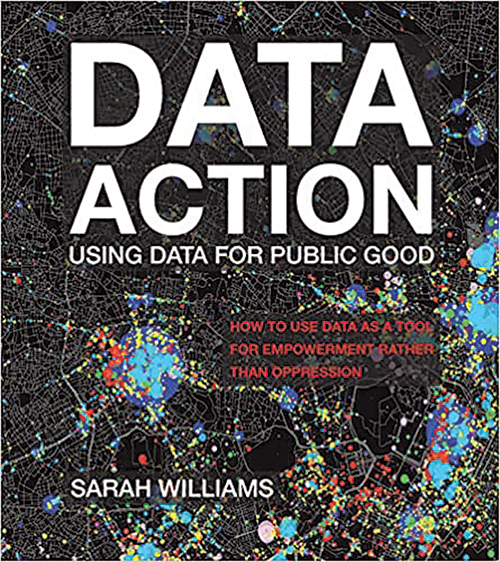
Data Action: Using Data for Public Good
Reviewed by Arthur David Olson and J.E. McNeil
August 1, 2021
By Sarah Williams. MIT Press, 2020. 312 pages. $39.95/hardcover; $24.99/eBook.
The intended focus of Data Action is described on the cover: “how to use data as a tool for empowerment rather than oppression.” The emphasis is on how nonprofessionals can be involved in data work, and on characteristics of projects that can help ensure those projects will reflect the interests of everyone in a community. An overarching theme might be described as “data is people,” collected by particular individuals with particular biases for particular purposes. The author’s succinct summary: “Data is never raw.” Being aware of who collected data as well as how and why it was collected is crucial to fully understanding and using it.
The book begins with a chapter of history that shows nothing is new in the use of data to shape and govern cities. Past uses both beneficial (surveying and reporting in England that identified the source of cholera in a neighborhood) and harmful (creation in the United States of “mortgage risk” maps that made systematic redlining possible) are covered, as is the invention of data presentation techniques we take for granted today, such as cadastral maps (detailed street and building maps) and even the humble bar chart. One section contrasts the quantitative analytics used by New York planner Robert Moses with the qualitative analytics of journalist and activist Jane Jacobs: “Jacobs believed the public’s voice should speak louder than data in the decision-making process.”
Williams emphasizes the value of presenting data in a form that one doesn’t need to be a data scientist to understand. One prominent example: a New York Times graph on University of Michigan racial discrimination that appeared as “a direct copy” in a Supreme Court dissent by Justice Sonia Sotomayor. The chapter also includes material on interactive maps on the web, where users can click on a map location to get information about it.
The emphasis is on new technologies—the Global Positioning System (GPS), smartphones, digital imagers, and electronic sensors—that make it possible for nonprofessionals to effectively collect data. Throughout the book, Williams points out that getting folks with different skills together for data work using these technologies (in particular, those involved who are affected by the work) is a way of building communities of interest. An unresolved question is the relative value of this method of creating communities.
While data collection is international in scope, as seen in recent projects in China, Kenya, and the United States that are described by Williams in detail, ownership of the data is more problematic. Discussing the use of existing data, Williams notes the present-day trend of “data colonialism”: data collected and held in the private hands of corporations. In some cases, it’s possible to “scrape” the data from websites using searches; care is required to get all relevant data. In other cases, a legal agreement may be required to secure the data; coming to agreement may be both costly and time-consuming. In all cases, there are privacy concerns for the individuals from whom the data was collected, knowingly or not.
There is much to like in this book, which is abundantly and attractively illustrated. Opening to the center and pressing nose to page lets readers experience a traditional book aroma. Beyond that, it is useful in helping amateurs understand the value and limitations of the tool of data collection and its representation.
But there are some editing lapses and data presentation miscues. And, while the book is useful as an overview of data as a tool for change, folks interested in a cookbook for taking data action will want to look elsewhere. This is not a DIY book.
Some questions arise from the book. In a time when the census is skewed and information about gun violence is suppressed, how can we assure that what data we have brings light to our struggles? How does the call to “speak truth to power” bear on this? And, echoing the spirit of Jane Jacobs’ concerns: how do we ensure that we go where the Spirit leads rather than where the data leads?
Arthur David Olson is an Adelphi (Md.) Meeting member, attends its Takoma Park preparative meeting, and is a retired programmer who founded the international time zone database.
J.E. McNeil is a Friends Meeting of Washington (D.C.) member, an activist attorney, and occasional number cruncher always looking for another opportunity to bring Light into discussions.


